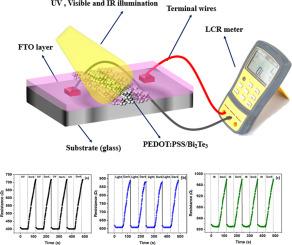PEDOT: PSS/Bi₂Te₃混合传感器中增强的uv -可见光到红外检测
IF 5.7
3区 材料科学
Q2 MATERIALS SCIENCE, MULTIDISCIPLINARY
引用次数: 0
摘要
在这里,我们报告了一种简单而廉价的传感器,能够测量宽范围的紫外线(UV)-可见光到红外(IR)照明。该器件采用滴铸技术在FTO玻璃基板上沉积聚3,4-乙烯二氧噻吩:聚苯乙烯磺酸盐(PEDOT: PSS)和碲化铋(Bi2Te3)基薄膜。所制备的PEDOT: PSS/Bi2Te3薄膜被用作活性材料来感知紫外、可见光和红外辐射。利用扫描电镜(SEM)和原子力显微镜(AFM)对制备的PEDOT: PSS/Bi2Te3传感器的表面形貌进行了研究。通过紫外可见吸收光谱和x射线衍射光谱(XRD)研究了所制备器件的吸收和组成。研究了在100hz、120hz和1khz频率下,光对器件电阻的影响。测量结果表明,随着紫外光、可见光和红外光强度从0-810 M/m2、0-14200 Lux和0-6850 W/m2的增加,电阻呈下降趋势。组装的器件响应对光强变化表现出良好的传感性能,具有良好的光响应,揭示了其潜在的光电探测器应用前景。此外,简单的制造工艺和廉价的材料进一步提升了它的意义。本文章由计算机程序翻译,如有差异,请以英文原文为准。

Enhanced UV–visible to infrared detection in PEDOT: PSS/Bi₂Te₃-based hybrid sensor
Here we report a simple and inexpensive sensor that is capable of measuring a wide range Ultraviolet (UV)-Visible to Infrared (IR) illuminations. The device was fabricated by depositing Poly3,4-ethylene dioxythiophene: polystyrene sulfonate (PEDOT: PSS) and Bismuth Telluride (Bi2Te3) based thin film on FTO glass substrate via drop casting technique. The deposited PEDOT: PSS/Bi2Te3 film was used as an active material to sense UV, Visible, and IR radiations. To investigate the surface morphology of PEDOT: PSS/Bi2Te3 based fabricated sensor, the scanning electron microscopy (SEM) and atomic force microscopy (AFM) were accomplished. UV-Vis absorption spectrum and X-ray diffraction spectroscopy (XRD) were obtained to study the absorption and composition of the fabricated device. The impact of light on the electrical resistance of the device at the frequency of 100 Hz, 120 Hz, and 1 kHz has been examined. The measurements indicate the declining trend in resistance as the intensity of UV, Visible and IR light increased from 0-810 M/m2,0-14200 Lux and 0-6850 W/m2. The assembled device response shows a splendid sensing performance towards variation in light intensity, with good photoresponse that discloses its potential photodetector applications. Besides, the easy fabrication technique along with inexpensive materials utilized further hoist its significance.
求助全文
通过发布文献求助,成功后即可免费获取论文全文。
去求助
来源期刊

Materials Research Bulletin
工程技术-材料科学:综合
CiteScore
9.80
自引率
5.60%
发文量
372
审稿时长
42 days
期刊介绍:
Materials Research Bulletin is an international journal reporting high-impact research on processing-structure-property relationships in functional materials and nanomaterials with interesting electronic, magnetic, optical, thermal, mechanical or catalytic properties. Papers purely on thermodynamics or theoretical calculations (e.g., density functional theory) do not fall within the scope of the journal unless they also demonstrate a clear link to physical properties. Topics covered include functional materials (e.g., dielectrics, pyroelectrics, piezoelectrics, ferroelectrics, relaxors, thermoelectrics, etc.); electrochemistry and solid-state ionics (e.g., photovoltaics, batteries, sensors, and fuel cells); nanomaterials, graphene, and nanocomposites; luminescence and photocatalysis; crystal-structure and defect-structure analysis; novel electronics; non-crystalline solids; flexible electronics; protein-material interactions; and polymeric ion-exchange membranes.
 求助内容:
求助内容: 应助结果提醒方式:
应助结果提醒方式:


